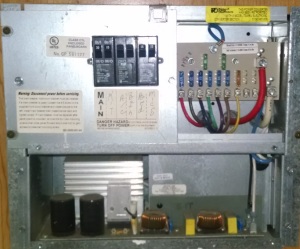 Our Mirada originally came with an electronic version (7345RU) of the old single stage converter / charger (6345). These units are designed to supply the coach with 12 volts and recharge the coach battery any time shore power (or generator power) is applied.
Our Mirada originally came with an electronic version (7345RU) of the old single stage converter / charger (6345). These units are designed to supply the coach with 12 volts and recharge the coach battery any time shore power (or generator power) is applied.
The unit worked fine as far as supplying 12 volt power to the coaches needs, but falls short of the needs to recharge the coach battery.
When charging the coach battery, the single stage unit is a compromise between a trickle charger and a boost charger. They don’t do a good job of trickle charging because the charge voltage is set to high and will boil water out of the battery of a short period of time. And, they don’t do a good job of boost charging because the charging voltage is set to low, this means it can take a long time (a day or two) to bring a discharged battery back up to a full charge.
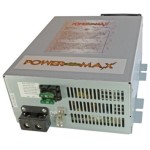 The way we use our Mirada, I chose to upgrade the converter to one of the new 4 stage units to overcome these problems. The unit I got is a 45 amp, 4 stage, sold by Best Converter.
The way we use our Mirada, I chose to upgrade the converter to one of the new 4 stage units to overcome these problems. The unit I got is a 45 amp, 4 stage, sold by Best Converter.
I’ve dealt with Best Converter in the past and they are good people who stand behind their products.
Our Mirada can sit for a couple months plugged into shore power, during that time, I want a trickle charge to maintain the battery.
When we hit the road, we often boondock and run off the battery. I want to be able to run the generator for 15-30 minutes every other day, and quickly bring the house battery up to full charge.
Four Stages provide four functions automatically, depending on what the converter sees:
14.6 – Boost Mode Output
13.6 – Normal Mode Output
13.2 – Float (trickle) Mode Output
Stage four is a De-sulfication mode

The upgrade replaces the power supply portion shown in the lower part of the converter. I also looked at the AC power circuit breakers (upper left), and had to to add a green ground wire for the power supply upgrade plug. I didn’t need to physically remove the fuse board, just loosten it up so I could gain access to the wires behind it.
To do this, you will need a drill and a dye grinder (or some way to cut sheet metal)
Step by Step
1) Remove AC power (shore power or generator power)
2) Disconnect the coach battery PLUS cables from the battery.
Using a voltmeter, verify the DC power (battery) is disconnected. Connect the voltmeter to the Red (+) and White (-) wires on the fuse panel to verify no 12 volts.
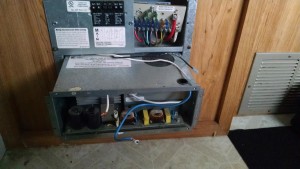
3) Remove the 2 screws that hold the fuse panel and tilt it outward.
4) Disconnect the DC wires from the fuse panel that come up from the old power supply.
The blue wire is on a bolt and nut, the white wire is in a terminal lug on the back side of the fuse panel. Tilt the fuse panel out to get to the terminal lug
5) Remove the AC power leads from the power supply.
These are black and white spade lugs, just pull them off of their connectors, lower right side of power supply from the
6) Remove the four screws that hold the power supply to the converter chassis
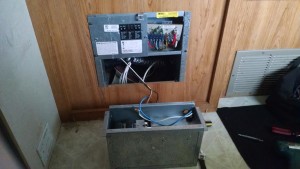
7) Slide the power supply out.
Its a tight fit feeding the DC wires down through the two holes. be careful.
IMPORTANT – Look up inside the converter where the power supply was just removed, there should be ample room behind the converter. The new power supply is going to stick out the back a couple inches, so we want to make sure there’s room behind the converter when we slide in the new power supply.
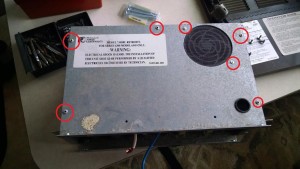
8) With the power supply out, drill out the 7 rivets shown.
9) Remove the cover and the fan from the cover.
Remove any remnants of the rivets from the lid.
10) Remove the screws that hold the power supply board to the bottom of the box.
These may be Torx screws. There is also one plastic screw, and a plastic guide that may need to be removed.
11) Remove the power supply board from the bottom of the box.
The board has a slit in it, you may need to remove the cardboard on the vertical partition, its held in place by two black plastic rivets.
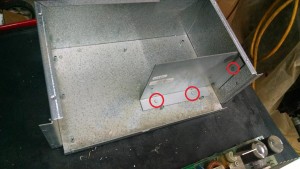
12) Drill out the three punch rivets and remove the partition panel
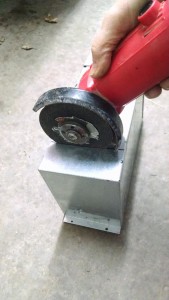
13) Using the new power supply as a guide, mark the back wall of the power supply box.
14) Cut the back wall out with a die grinder.
Use file or grinder and remove sharp edges.
The new power supply needs good ventilation. If yours is small enough, you could probably mount it sideways, but you would need to cut a hole in the side of the box for air. I chose to just cut out the back of the box and mount the new power supply so it sticks out the back.
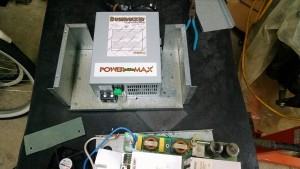
15) Drill four holes in the bottom of the box and use hardware to mount the power supply to the bottom of the box.
You will need to break off the studs that held the old power supply board. A pair of pliers and just bend back and forth,
16) Install the top cover back on the box
Use four sheet metal screws to hold the top cover on
17) Connect the DC wires to the new power supply.
I reused the blue and white wires from the old power supply. Use caution, the (+) and (-) are hard to see on the new power supply.
18) Install AC power plug on old wires.
Rather than wiring the new power supplies AC cord directly to the circuit breaker, I installed a female AC plug on the old AC power wires (yellow connector in photo). I also added a green ground wire to the plug and routed it into circuit breaker compartment (upper left)
I can then plug the new power supply into this outlet and not alter the new power supply and possibly void a warranty.
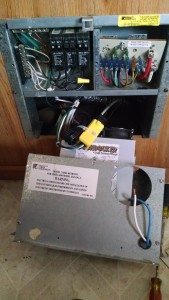
19) Slide the new power supply box back into the converter
Carefully feed the blue and white DC wires back through the two sets of holes and route them behind the fuse panel
20) TEST for DC power
Identify mark the correct circuit breaker for the power supply.
Before hooking up the DC wires, turn AC power back on, Using your voltmeter, you should read about 14.6 volts coming out of the power supply.
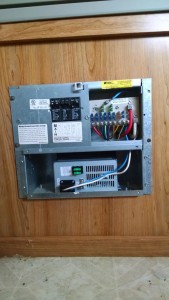
21) Turn the AC back off – Verify with voltmeter it is OFF (no DC output)
22) Connect the DC wires to the Fuse Panel.
Use caution, make sure the wires are not pinched behind the fuse panel. re-install the two screws that hold the fuse panel. Use wire ties to secure lose wiring.
23) Reconnect the coach battery.
You should see 13 volts (whatever the battery is) at the large red and white cables on the fuse panel
24) Turn the AC circuit breaker back on.
You should see the battery voltage jump to about 14.7 volts. (Boost Mode).
25) Monitor voltage.
Monitor the battery voltage for a while. It should slowly drop down to 13.6 volts as the battery charges.
As the battery reaches full charge, you’ll see the voltage drop down to 13.2 volts (trickle mode)

great job on the upgrade and the professional quality ‘how to’ acticle. glad to see quality people doing positive things for the RV community.
diverdennis & beth
dewitt, mi